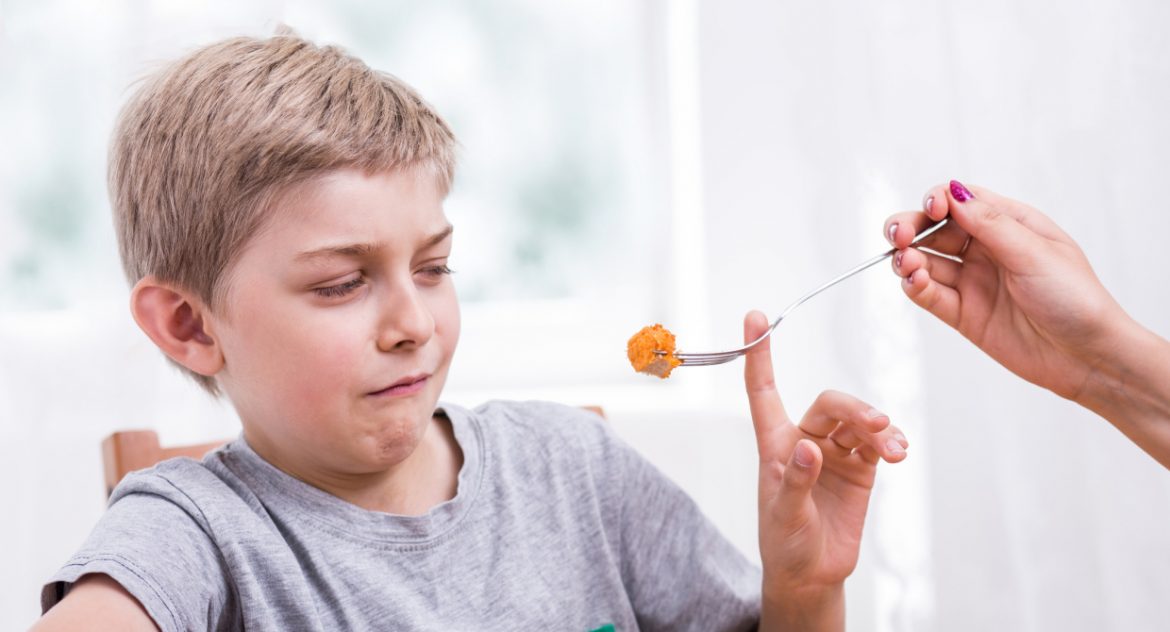1 サマリー 偏食克服は「味覚の旅」を親子で歩むこと
「野菜を見ただけでイヤ」「同じメニューしか食べない」。そんな偏食行動に頭を抱える家庭は多いものです。しかし味覚の発達は、生まれつき決まった才能ではなく、経験によって広がる可塑的な能力です。本ブログでは、乳幼児期から学童期までの味覚発達メカニズムを紐解き、偏食克服の段階的アプローチを紹介します。ゴールは「嫌いをなくす」よりも「試してみる勇気を育てる」こと。
偏食克服の柱は
1 味覚発達のステージを理解する
2 五感を使ったポジティブ経験を積む
3 親子でストレスを減らす食環境を整える
これらを実践することで、食卓は「戦場」ではなく「発見のラボ」へと変わります。
2 味覚発達のステージと脳の仕組み
赤ちゃんの舌には、大人の約2倍もの味蕾が存在し、甘味に対して最も反応しやすい状態からスタートします。
1 生後0〜6か月 母乳やミルクの甘味を好む本能期
2 生後7〜18か月 離乳食期で苦味や酸味に初遭遇する探索期
3 1歳半〜3歳 自己主張と警戒心が高まるネオフォビア期
4 4歳以降 社会的要素で好みが広がる模倣学習期
特にネオフォビア期は「食の警戒心」が脳の扁桃体を介して強まります。この時期に無理強いをすると、嫌悪記憶が海馬に刻まれ、長期偏食リスクが上がることが研究で示されています。逆に「見た・触れた・におった」を十分に経験させると、前頭前野が刺激され好奇心が勝りやすくなるため、親は「食べなくてもOK」を合言葉に観察機会を増やすことが重要です。
3 偏食を生む三つの要因
1 感覚過敏
味だけでなく、においや食感、温度に対しても過敏な子は多く、ザラザラや繊維質が苦手なケースが典型。
2 学習経験
「これは嫌い」と言った瞬間に別メニューを用意されると、拒否行動が強化されます。
3 心理社会的要素
兄弟げんかや親子の緊張が高い食卓は、交感神経が優位になり、唾液分泌が減少し味が濃く感じられます。
これらの要因は単独ではなく複合的に作用します。感覚過敏が強い子ほど「学習経験の負のスパイラル」に陥りやすいため、刺激コントロールと成功体験の設計がカギとなります。
4 五感アプローチで味覚の壁を越える
味覚だけでなく視覚・嗅覚・触覚・聴覚を利用して食材への親近感を育てます。
1 視覚 色鮮やかな盛り付けで「食べてみたい」を引き出す
2 嗅覚 調理前に香りクイズを行い、認知的関与を高める
3 触覚 調理のお手伝いで生野菜の質感を楽しむ
4 聴覚 ポリポリ、サクサクなど音の語彙を共有する
5 味覚 ひとかけサイズでミニテイスティングを実施
五感のうち二つ以上を同時に刺激するとドーパミン分泌が高まり、脳の報酬系が活性化します。「自分で触り、においをかぐ」経験は、口に入れる前段階のハードルを大きく下げることが実証されています。
5 ストレスを減らす食卓環境と声かけ
子どもの副交感神経を優位にするには、リラックスした雰囲気づくりが不可欠です。
1 照明を暖色系にし、テレビやスマホは食前にオフ
2 食事開始10分前に「あと少しでごはんだよ」と予告
3 「一口チャレンジシール表」をテーブルに貼り進捗を可視化
4 拒否されたときは「今日は見るだけで大丈夫」と肯定的に終える
5 食事後は味の感想より「一緒に食べられて嬉しかった」と関係性を強調
これにより、食卓は評価の場ではなく交流の場となり、子どもは安心して新しい味に向き合えます。
6 年齢別克服プランの作り方
【2〜3歳】
ピックアップ式 テーブル中央に盛り合わせ皿を用意し、子どもが自分で選んで皿に移す「自分で決めた感」を重視。
【4〜6歳】
色と形のバリエーション作戦 赤黄緑の信号プレートを用意し、試した食材を色で記録。週末に「信号ゲーム」で全色そろったら家族で拍手。
【7〜9歳】
味覚探偵ミッション 「苦味の少ない順番に並べ替え」などゲーム要素を加え客観的探究心を刺激。
【10歳以上】
栄養データ解析チャレンジ 自分の朝食メニューをアプリで記録し、栄養素グラフを見ながら改善ポイントを発表。
段階的に自律的判断を促す設計にすることで、多様な味を「自分ゴト」として取り込みやすくなります。
7 家庭で使える実践アイデア 10ステップ
1 一口サイズの「ミニ農園バー」で新鮮野菜スティックを並べる
2 野菜スタンプで絵はがきを作り、食材への親近感を高める
3 スムージー実験室 苦手野菜をフルーツと混ぜ味覚のグラデーションを体験
4 月1回の「色逆転カレー」 ほうれん草で緑カレー、ビーツでピンクカレーを作り色彩感覚を刺激
5 味覚日記 新しい食材を試した日には顔マークで感情を記録
6 農家さんライブ配信 オンラインで生産者と対話し食材のストーリーを知る
7 香りマッチングゲーム 瓶に入れたスパイスを嗅ぎ、料理写真とペアを当てる
8 親子クックオフ 同じ食材を使って別レシピを競い、食べ比べを楽しむ
9 「変身クッキング」 嫌いな野菜を粉末やペーストにして別料理へ応用
10 ご褒美は食とは無関係に 新味への挑戦を物やお菓子で釣らず、家族散歩など非食報酬で強化
行ごとに分かれたステップにより、親が選びやすく継続しやすい構造になっています。
8 まとめ 偏食克服を継続する三つのカギ
1 発達段階に合わせた「味覚の旅マップ」を作り、焦らず進む
2 五感体験とリラックス環境で「試すハードル」を下げる
3 親子でデータと感情を可視化し、小さな成功を積み上げる
偏食は一夜で治るものではありませんが、味覚は生涯にわたり更新可能な能力です。今日から一口の「見る」「触る」「におう」を増やし、家族で味覚の冒険に出かけましょう。小さな挑戦の連続が、やがて豊かな食体験と健康的な未来へとつながります。
Healing Picky Eating! The Process of Taste Development and How to Overcome Food Aversions in Children
1 Summary – Turning the Table from “Battlefield” to “Discovery Lab”
“Vegetables? No way.” “Only my favorite dish, please.”
Many families wrestle with these picky-eating behaviors, but taste is not a fixed talent—it is a flexible ability shaped by experience. This blog unpacks how children’s taste develops from infancy through the elementary years and offers a stage-by-stage roadmap for conquering food aversions.
Key pillars:
1 Understand the developmental stages of taste.
2 Create positive, multisensory food experiences.
3 Design a low-stress dining environment for parent and child.
Mastering these turns mealtime from a source of conflict into a space of exploration.
2 The Stages of Taste Development and the Brain at Work
Newborn tongues contain roughly twice as many taste buds as an adult’s and respond most strongly to sweetness.
Stage 1 0–6 months Innate phase, loving the sweetness of breastmilk or formula.
Stage 2 7–18 months Exploration phase, first encounters with bitter and sour flavors during weaning.
Stage 3 1½–3 years Neophobia phase, when self-assertion and caution peak.
Stage 4 4 years + Imitative-learning phase, where social cues broaden preferences.
During the neophobia phase, the brain’s amygdala heightens “food caution.” If adults force bites now, the hippocampus may store strong disgust memories, increasing long-term picky-eating risk. Conversely, letting children see, touch, and smell foods—without requiring them to eat—stimulates the prefrontal cortex, tipping the balance toward curiosity. “It’s okay if you don’t eat it” should be the family mantra while offering plenty of observation chances.
3 Three Factors That Produce Picky Eating
1 Sensory hypersensitivity
Texture, smell, or temperature can overwhelm—fibrous or gritty foods are classic triggers.
2 Learning history
When one “I don’t like it” instantly earns a replacement dish, refusal behavior is reinforced.
3 Psychosocial context
High tension at the table (e.g., sibling fights) activates the sympathetic nervous system, reduces saliva, and makes flavors feel harsher.
These factors rarely act alone. A sensory-sensitive child can quickly spiral into persistent pickiness unless stimuli are moderated and success experiences are engineered.
4 A Five-Sense Approach to Cross the Flavor Barrier
Use all the senses to build comfort with new foods.
1 Vision Serve colorful plates to trigger “I want to try.”
2 Smell Play a “Guess the aroma” game before cooking to boost cognitive engagement.
3 Touch Invite children to prep veggies and explore textures.
4 Hearing Share words like crunch or snap and listen together.
5 Taste Offer mini-tasting bites in pea-sized portions.
Stimulating at least two senses at once raises dopamine and activates the brain’s reward circuits. Handling and sniffing foods before tasting dramatically lowers the entry barrier.
5 Creating a Low-Stress Table and Supportive Phrases
To shift the child into parasympathetic “rest and digest” mode:
1 Use warm lighting; turn off TV and phones before seating.
2 Give a ten-minute “Dinner’s almost ready” warning.
3 Post a “One-Bite Challenge” sticker chart on the table.
4 If the food is refused, say, “Just looking is fine today,” and end positively.
5 Afterward, highlight connection—“I loved eating together”—rather than critiquing flavors.
The table becomes a place for interaction, not appraisal, letting children face new tastes with confidence.
6 Age-Specific Action Plans
Ages 2–3
“Pick-and-Place” buffet—put a shared platter in the center so the child chooses what lands on their plate, fostering ownership.
Ages 4–6
“Color & Shape” tactic—use red, yellow, and green plates as a traffic-light log. If all colors appear by week’s end, celebrate together.
Ages 7–9
“Taste Detective” missions—rank foods from least to most bitter, turning experiments into a game of discovery.
Age 10 +
“Nutrient Analyst” challenge—record breakfast in an app, view nutrient graphs, and present improvement ideas.
Gradually shifting responsibility lets children internalize a diverse diet as “my project.”
7 Ten Practical Steps for Home (each on its own line)
1 Set up a “mini farmers’ bar” of bite-size fresh vegetable sticks.
2 Make vegetable stamps for postcards to build food familiarity.
3 Run a smoothie lab blending disliked veggies with fruits to explore flavor gradients.
4 Try a monthly “color-swap curry,” using spinach for green or beetroot for pink.
5 Keep a taste diary, marking feelings with emoji faces.
6 Attend live streams with farmers to learn each food’s story.
7 Play a scent-matching game, pairing spice jars with dish photos.
8 Hold a parent-child cook-off, comparing different recipes from the same ingredient.
9 Use “food transformation” tricks—turn a hated veggie into powder or purée for another dish.
10 Reward new-flavor attempts with non-food treats, like a family walk, not candy.
8 Conclusion – Three Keys to Sustainable Progress
1 Create a “Taste-Journey Map” aligned with developmental stages—advance slowly, without haste.
2 Lower the trial barrier through multisensory play and a calm atmosphere.
3 Visualize data and emotions together, stacking tiny wins.
Picky eating never disappears overnight, yet taste remains plastic throughout life. Start today by adding one more see-touch-smell moment, and set off on a family flavor adventure. Small, repeated challenges lead to richer eating experiences and a healthier future.



コメント